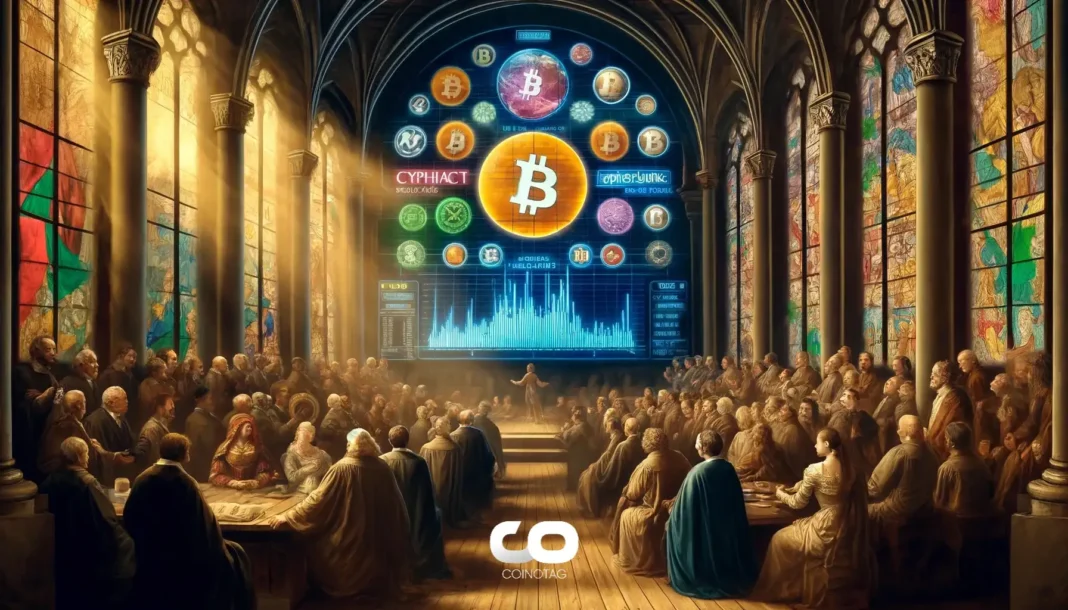| COINOTAG recommends • Exchange signup |
| 💹 Trade with pro tools |
| Fast execution, robust charts, clean risk controls. |
| 👉 Open account → |
| COINOTAG recommends • Exchange signup |
| 🚀 Smooth orders, clear control |
| Advanced order types and market depth in one view. |
| 👉 Create account → |
| COINOTAG recommends • Exchange signup |
| 📈 Clarity in volatile markets |
| Plan entries & exits, manage positions with discipline. |
| 👉 Sign up → |
| COINOTAG recommends • Exchange signup |
| ⚡ Speed, depth, reliability |
| Execute confidently when timing matters. |
| 👉 Open account → |
| COINOTAG recommends • Exchange signup |
| 🧭 A focused workflow for traders |
| Alerts, watchlists, and a repeatable process. |
| 👉 Get started → |
| COINOTAG recommends • Exchange signup |
| ✅ Data‑driven decisions |
| Focus on process—not noise. |
| 👉 Sign up → |
-
The resilience of Bitcoin continues to face scrutiny as skeptics proliferate narratives filled with fear, uncertainty, and doubt (FUD), especially during market surges.
-
This skepticism is fueled by concerns over Bitcoin’s perceived lack of value, security issues, and environmental impact, yet the cryptocurrency’s growth persists.
-
Dan Held, a vocal proponent of Bitcoin, highlights these conflicts, stating, “Naysayers try to cope with missing the boat by rationalizing why it will fail through ‘Fear, Uncertainty, and Doubt.’”
This article explores common Bitcoin FUD narratives, examining their validity and analyzing the cryptocurrency’s evolving narrative against historical and financial perspectives.
Debunking Bitcoin’s Lack of Intrinsic Value
Critics like investors Warren Buffett and Charlie Munger persistently argue that Bitcoin lacks intrinsic value, labeling it as speculative and volatile. Buffett once proclaimed Bitcoin as “rat poison squared,” claiming it yields no dividends or earnings. Munger characterized the cryptocurrency as “disgusting,” suggesting its existence contradicts civilized interests.
Despite such criticisms, Bitcoin has consistently demonstrated growth since its inception, solidifying its status as a leading asset. A Federal Reserve review article by economists Aleksander Berentsen and Fabian Schär supports this view, claiming, “Bitcoin is not the only currency that has no intrinsic value. State monopoly currencies… have no intrinsic value either.” This assertion illustrates that the measure of intrinsic value is subjective and often reliant on societal perceptions and utility.
Bitcoin’s fixed supply of 21 million coins and its increasing institutional adoption, particularly with developments like Bitcoin exchange-traded funds (ETFs), position it as a considerable store of value, comparable to gold.
| COINOTAG recommends • Professional traders group |
| 💎 Join a professional trading community |
| Work with senior traders, research‑backed setups, and risk‑first frameworks. |
| 👉 Join the group → |
| COINOTAG recommends • Professional traders group |
| 📊 Transparent performance, real process |
| Spot strategies with documented months of triple‑digit runs during strong trends; futures plans use defined R:R and sizing. |
| 👉 Get access → |
| COINOTAG recommends • Professional traders group |
| 🧭 Research → Plan → Execute |
| Daily levels, watchlists, and post‑trade reviews to build consistency. |
| 👉 Join now → |
| COINOTAG recommends • Professional traders group |
| 🛡️ Risk comes first |
| Sizing methods, invalidation rules, and R‑multiples baked into every plan. |
| 👉 Start today → |
| COINOTAG recommends • Professional traders group |
| 🧠 Learn the “why” behind each trade |
| Live breakdowns, playbooks, and framework‑first education. |
| 👉 Join the group → |
| COINOTAG recommends • Professional traders group |
| 🚀 Insider • APEX • INNER CIRCLE |
| Choose the depth you need—tools, coaching, and member rooms. |
| 👉 Explore tiers → |
The Fallacy of Tulip Mania Comparisons
Bitcoin’s parabolic price increases have led some market watchers to liken it to historical bubbles like the Dutch tulip mania. However, regaining a clearer perspective, Held insists that Bitcoin serves a unique purpose in providing a digital store of value that is resistant to seizure and adaptable to market needs.
Recent sentiments from JPMorgan’s CEO Jamie Dimon show a shift from past criticisms. Dimon initially labeled Bitcoin a “fraud” but later acknowledged its persistence amid growing market acceptance, noting that “fads typically don’t last 12 years.” Unlike past bubbles, Bitcoin has managed to avoid catastrophic collapses that hinder an asset’s recovery.
| COINOTAG recommends • Exchange signup |
| 📈 Clear interface, precise orders |
| Sharp entries & exits with actionable alerts. |
| 👉 Create free account → |
| COINOTAG recommends • Exchange signup |
| 🧠 Smarter tools. Better decisions. |
| Depth analytics and risk features in one view. |
| 👉 Sign up → |
| COINOTAG recommends • Exchange signup |
| 🎯 Take control of entries & exits |
| Set alerts, define stops, execute consistently. |
| 👉 Open account → |
| COINOTAG recommends • Exchange signup |
| 🛠️ From idea to execution |
| Turn setups into plans with practical order types. |
| 👉 Join now → |
| COINOTAG recommends • Exchange signup |
| 📋 Trade your plan |
| Watchlists and routing that support focus. |
| 👉 Get started → |
| COINOTAG recommends • Exchange signup |
| 📊 Precision without the noise |
| Data‑first workflows for active traders. |
| 👉 Sign up → |
The Misconception of Bitcoin as a Money Laundering Tool
Senator Elizabeth Warren’s claim that Bitcoin serves primarily as a vehicle for money laundering highlights a misunderstanding of the cryptocurrency’s transparency. The Bitcoin blockchain is inherently designed to make transactions traceable, contradicting the argument that it facilitates illicit activities.
While some services may assist in obscuring Bitcoin’s trail, such practices are dwarfed by the transparency of blockchain technology. Held notes, “The problem rests with government money, not Bitcoin, which most operate on transparent ledgers that make it hard to obfuscate funds.”
| COINOTAG recommends • Traders club |
| ⚡ Futures with discipline |
| Defined R:R, pre‑set invalidation, execution checklists. |
| 👉 Join the club → |
| COINOTAG recommends • Traders club |
| 🎯 Spot strategies that compound |
| Momentum & accumulation frameworks managed with clear risk. |
| 👉 Get access → |
| COINOTAG recommends • Traders club |
| 🏛️ APEX tier for serious traders |
| Deep dives, analyst Q&A, and accountability sprints. |
| 👉 Explore APEX → |
| COINOTAG recommends • Traders club |
| 📈 Real‑time market structure |
| Key levels, liquidity zones, and actionable context. |
| 👉 Join now → |
| COINOTAG recommends • Traders club |
| 🔔 Smart alerts, not noise |
| Context‑rich notifications tied to plans and risk—never hype. |
| 👉 Get access → |
| COINOTAG recommends • Traders club |
| 🤝 Peer review & coaching |
| Hands‑on feedback that sharpens execution and risk control. |
| 👉 Join the club → |
Bitcoin’s Energy Consumption and Environmental Impact
Critics often cite Bitcoin’s energy use, particularly its proof-of-work (PoW) mining process, as unsustainable. However, this narrative does not consider the increasing shift toward renewable energy sources within the mining community. Bitcoin’s energy consumption has reached levels comparable to entire countries, provoking valid concerns about its environmental footprint.
Held defends Bitcoin’s energy model, urging critics to contextualize its consumption against traditional industries’ energy use. New research indicates that Bitcoin mining could accelerate the adoption of renewable energy by monetizing excess energy produced, creating a potential revenue stream for sustainable practices.
Confronting the Quantum Computing Threat
With advancements in quantum computing posing a theoretical risk to Bitcoin’s security, fear abounds regarding its potential vulnerability. However, experts argue that the urgency around quantum threats oversimplifies the situation. Held reassures that Bitcoin’s protocol can adapt if a viable quantum threat emerges, indicating the landscape of crypto security is resilient and proactive.
The Tether Conundrum: Fear of Collapse
Tether USDt (USDT), the largest stablecoin tied closely to Bitcoin, is often at the center of FUD narratives concerning the cryptocurrency’s stability. Critics argue that Tether lacks transparency in its reserves, heightening fears of systemic risk in the broader crypto market. Nonetheless, experts like Held posit that while a Tether failure would have severe implications, Bitcoin’s fundamental structure remains robust enough to withstand such an event.
| COINOTAG recommends • Exchange signup |
| 📈 Clear control for futures |
| Sizing, stops, and scenario planning tools. |
| 👉 Open futures account → |
| COINOTAG recommends • Exchange signup |
| 🧩 Structure your futures trades |
| Define entries & exits with advanced orders. |
| 👉 Sign up → |
| COINOTAG recommends • Exchange signup |
| 🛡️ Control volatility |
| Automate alerts and manage positions with discipline. |
| 👉 Get started → |
| COINOTAG recommends • Exchange signup |
| ⚙️ Execution you can rely on |
| Fast routing and meaningful depth insights. |
| 👉 Create account → |
| COINOTAG recommends • Exchange signup |
| 📒 Plan. Execute. Review. |
| Frameworks for consistent decision‑making. |
| 👉 Join now → |
| COINOTAG recommends • Exchange signup |
| 🧩 Choose clarity over complexity |
| Actionable, pro‑grade tools—no fluff. |
| 👉 Open account → |
This ongoing debate highlights the need for clearer regulations and transparency in the stablecoin sector to bolster investor confidence in the crypto landscape.
Conclusion
The assertions surrounding Bitcoin often stem from a misunderstanding of its technology and value proposition. As Bitcoin faces challenges regarding its intrinsic value, energy consumption, and market criticisms, its endurance as a transformative financial asset remains strong. By fostering a deeper understanding of these key narratives, investors can navigate the complexities of the crypto market with greater confidence, recognizing that Bitcoin is more than a fleeting trend—it is a revolutionary force in global finance.
| COINOTAG recommends • Members‑only research |
| 📌 Curated setups, clearly explained |
| Entry, invalidation, targets, and R:R defined before execution. |
| 👉 Get access → |
| COINOTAG recommends • Members‑only research |
| 🧠 Data‑led decision making |
| Technical + flow + context synthesized into actionable plans. |
| 👉 Join now → |
| COINOTAG recommends • Members‑only research |
| 🧱 Consistency over hype |
| Repeatable rules, realistic expectations, and a calmer mindset. |
| 👉 Get access → |
| COINOTAG recommends • Members‑only research |
| 🕒 Patience is an edge |
| Wait for confirmation and manage risk with checklists. |
| 👉 Join now → |
| COINOTAG recommends • Members‑only research |
| 💼 Professional mentorship |
| Guidance from seasoned traders and structured feedback loops. |
| 👉 Get access → |
| COINOTAG recommends • Members‑only research |
| 🧮 Track • Review • Improve |
| Documented PnL tracking and post‑mortems to accelerate learning. |
| 👉 Join now → |
| COINOTAG recommends • Members‑only research |
| 📌 Curated setups, clearly explained |
| Entry, invalidation, targets, and R:R defined before execution. |
| 👉 Get access → |
| COINOTAG recommends • Members‑only research |
| 🧠 Data‑led decision making |
| Technical + flow + context synthesized into actionable plans. |
| 👉 Join now → |
| COINOTAG recommends • Members‑only research |
| 🧱 Consistency over hype |
| Repeatable rules, realistic expectations, and a calmer mindset. |
| 👉 Get access → |
| COINOTAG recommends • Members‑only research |
| 🕒 Patience is an edge |
| Wait for confirmation and manage risk with checklists. |
| 👉 Join now → |
| COINOTAG recommends • Members‑only research |
| 💼 Professional mentorship |
| Guidance from seasoned traders and structured feedback loops. |
| 👉 Get access → |
| COINOTAG recommends • Members‑only research |
| 🧮 Track • Review • Improve |
| Documented PnL tracking and post‑mortems to accelerate learning. |
| 👉 Join now → |







